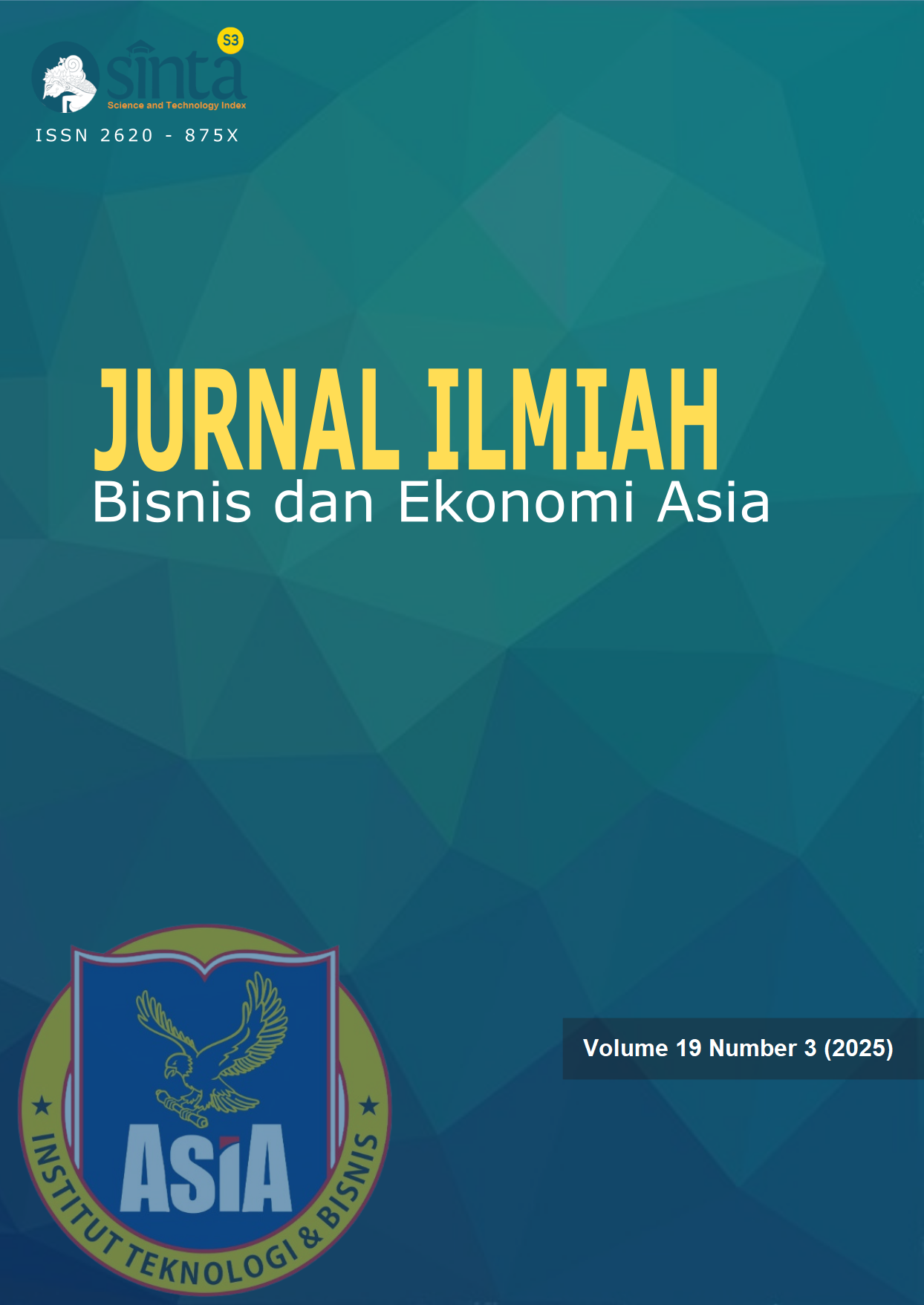Dilemma of Hospital Nurses in Malang City: When Job Stress Triggers Turnover Intention, Can Burnout and Job Satisfaction Mediate?
DOI:
https://doi.org/10.32815/jibeka.v19i3.2381Keywords:
job satisfaction, Burnout, job stress, turnover intention, hospital nursesArticle Metrics
Abstract
The persistent health problems in Indonesia have forced the government to act so that the public can still feel justice and obtain their rights. Since the government regulation regarding the tiered referral system was implemented, there has been an increase in referrals to D-type and C-type hospitals because of their position as the first-level referral facility in the BPJS health service program. In the healthcare industry, nurses play a crucial role as essential human resources in hospitals, responsible for monitoring patient health and providing care. However, hospitals continue to grapple with the serious issue of employees intending to leave their jobs. The data collection technique in this study was to use questionnaires distributed directly and randomly through Google Forms to 100 respondents from C-type hospital nurses in Malang City. The data collected was analyzed using Structural Equation Modeling (SEM-PLS). The research findings conclude that turnover intention is directly influenced by job stress, burnout, and job satisfaction, and that the job stress variable has a positive effect on burnout and job satisfaction. Additionally, Burnout and Job Satisfaction mediate the influence of Job Stress on turnover intention.
Downloads
References
Ahmad, F., & Afgan, S. (2016). The relationship between occupational stress and burnout among employees working in private banks. International Journal of Business and Social Science, 7(3), 45–52.
Ambarwati, Ayu, Retno Purwani Setyaningrum, and Fitri Rezeki. 2024. “The Effect of Burnout and Job Stress on Turnover Intention With Work-Life Balance As a Mediating Variable in Millennial Employees of Pt. Abc and Pt. Xyz in Bekasi Regency.” Indonesian Interdisciplinary Journal of Sharia Economics (IIJSE) 7(2): 4073–90.
Anwar, S., & Shahzad, K. (2011). Impact of work stress on employee burnout: A study of banking sector employees in Pakistan. Interdisciplinary Journal of Contemporary Research in Business, 3(8), 260–272.
Arik Prasetya, Hafsah Khairunnisa, Aulia Luqman Aziz, 2021. The Effect of Work Stress and Burnout on Job Satisfaction and Employee Performance, Proceedings of the 3rd Annual International Conference on Public and Business Administration (AICoBPA 2020), Atlantis Press, ISSN 2352-5428, https://doi.org/10.2991/aebmr.k.210928.016, DOI 10.2991/aebmr.k.210928.016
Bakker, A. B., & Demerouti, E. (2007). The job demands-resources model: State of the art. Journal of Managerial Psychology, 22(3), 309–328.
Cahyani Purnasari, Marianti A Manggau, Hasyim Kasim. Studi Pengaruh Dosis Dan Lama Penggunaan Terapi Aminoglikosida Terhadap Fungsi Ginjal. Majalah Farmasi dan Farmakologi Vol 22 no 3.
Dewi P. S. A., and Sriathi A.A.A., “Pengaruh Stres Kerja Terhadap Turnover Intention Yang Dimediasi Oleh Kepuasan Kerja,” E-Jurnal Manaj. Univ. Udayana, vol. 8, no. 6, p. 3646, 2019, doi: 10.24843/ejmunud.2019.v08.i06.p13.
Desiana, Putri Mega, Mone Stepanus Andrias, and Gyandra Sekar Ahyinaa. 2024. “The Mediating Effect of Job Stress and Well-Being on Turnover Intention in Indonesia.” Problems and Perspectives in Management 22(2): 477–87. doi:10.21511/ppm.22(2).2024.37.
Fathorrahman, “Faktor Yang Mempengaruhi Kinerja Dan Kinerja Sebagai Variabel Mediasi Pengaruh Komitmen Organisasional Terhadap Kepuasan Kerja Dosen Perguruan Tinggi Swasta Di Malang,” EKUITAS (Jurnal Ekon. dan Keuangan), vol. 2, no. 3, pp. 360–384, 2019, doi: 10.24034/j25485024.y2018.v2.i3.3934.
Fina Yusuf. 2010. Kajian terhadap kecenderungan terhadap turnover perawat di Pelayanan Kesehatan Sint Carolus,2010 = Study of Nurses Turnover Tendency in PK Sint Carolus. URI: https://lib.ui.ac.id/m/detail.jsp?id=20308315&lokasi=lokal
Gretchen L Birbeck 1, Ron D Hays, Xinping Cui, Barbara G Vickrey . 2002. Seizure reduction and quality of life improvements in people with epilepsy. Epilepsia. Vol 43(5). Page 535-8. doi: 10.1046/j.1528-1157.2002.32201.x.
Hair J.F. Jr., “Partial Least Squares Structural Equation Modeling (PLS-SEM): An Emerging Tool in Business Research,” Eur. Bus. Rev., vol. 26, pp. 106–121, 2014, doi: https://doi.org/10.1108/EBR-10-2013-0128.
Jaafar, Syaiful. 2021. “The Relationship between Stress and Job Satisfaction.” International Journal of Business and Management 5: 8–12. doi:10.26666/rmp.ijbm.2021.1.2.
Jex, S. M., & Beehr, T. A. (1991). Emerging theoretical and methodological issues in the study of work-related stress. Research in Personnel and Human Resources Management, 9, 311–365
Jung, H. S., Jung, Y. S., & Yoon, H. H. (2021). COVID-19: The effects of job insecurity on the job engagement and turnover intent of deluxe hotel employees and the moderating role of generational characteristics. International Journal of Hospitality Management, 92, 102703
Kaffaso, Yoseph Vernon Suardi, and Luh Putu Mahyuni. 2024. “Antecedents of Turnover Intention in Millennial Employees: Job Stress and Organizational Culture as Mediation Variables.” International Journal of Science and Society 6(2): 281–92. doi:10.54783/ijsoc.v6i2.1138.
Kim, H., & Kao, D. (2014). A meta-analysis of turnover intention predictors among U.S. child welfare workers. Children and Youth Services Review, 47(3), 214–223.
Labrague, Leodoro, McEnroe-Petitte, Denise, Papathanasiou Ioanna, Olaide Bamidele Edet. 2015. Nursing Students’ Perceptions of Their Own Caring Behaviors: A Multicountry Study. International Journal of Nursing Knowledge 26(4). DOI:10.1111/2047-3095.12108
L Abushaikha1, H Saca-Hazboun. 2009. Job satisfaction and burnout among Palestinian nurses. East Mediterr Health Journal. Vol 15(1):190-7.
Lazarus, R. S., & Folkman, S. (1984). Stress, appraisal, and coping. Springer Publishing Company.
Locke, E. A. (1976). The nature and causes of job satisfaction. In M. D. Dunnette (Ed.), Handbook of industrial and organizational psychology (pp. 1297–1349). Rand McNally.
Lum, L., Kervin, J., Clark, K., Reid, F., & Sirola, W. (1998). Explaining nursing turnover intent: Job satisfaction, pay satisfaction, or organizational commitment? Journal of Organizational Behavior, 19(3), 305–320.
Lu, A. C. C., Gursoy, D., & Neale, N. R. (2017). Work engagement, job satisfaction, and turnover intentions: A comparison between supervisors and line-level employees. International Journal of Contemporary Hospitality Management, 29(1), 170–193.
Mardikaningsih, R., & Sinambela, E. A. . (2022). Impact of Burnout and Stress on Employee Satisfaction in Work . International Journal of Service Science, Management, Engineering, and Technology, 2(1), 21–25. Retrieved from https://ejournalisse.com/index.php/isse/article/view/25
Martin. A. E.,, 2008. A Dictionary of Nursing. Oxford University press.
Maslach, C., & Leiter, M. P. (1997). The truth about burnout: How organizations cause personal stress and what to do about it. Jossey-Bass.
Mobley, W. H. (1977). Intermediate linkages in the relationship between job satisfaction and employee turnover. Journal of Applied Psychology, 62(2), 237–240.
Nakao H, Yamazaki M, Tsuboi R, Ogawa H. Mixture of sugar and povidone-iodine stimulates wound healing by activating keratinocytes and fibroblast functions. Arch Dermatol Res. 2006 Sep;298(4):175-82. doi: 10.1007/s00403-006-0683-z. Epub 2006 Jul 22. PMID: 16862430.
Natasha Khamisa, Karl Peltzer, Dragan Ilic, Brian Oldenburg, 2017. Effect of personal and work stress on burnout, job satisfaction and general health of hospital nurses in South Africa, Health SA Gesondheid, Volume 22, Pages 252-258, ISSN 1025-9848, https://doi.org/10.1016/j.hsag.2016.10.001.
Naser Hoboubi, Alireza Choobineh, Fatemeh Kamari Ghanavati, Sareh Keshavarzi, Ali Akbar Hosseini, The Impact of Job Stress and Job Satisfaction on Workforce Productivity in an Iranian Petrochemical Industry, Safety and Health at Work, Volume 8, Issue 1, 2017, Pages 67-71,ISSN 2093-7911, https://doi.org/10.1016/j.shaw.2016.07.002. (https://www.sciencedirect.com/science/article/pii/S2093791116300841)
Naufer, F. Z., and P. D. A. S. Kumar. 2020. “Impact of Job Stress on Turnover Intention: Study of Third Space Global (Pvt) Limited.” Kelaniya Journal of Human Resource Management 15(1): 71. doi:10.4038/kjhrm.v15i1.73.
Ning. L. et al., “The mediating role of job satisfaction and presenteeism on the relationship between job stress and turnover intention among primary health care workers,” Int. J. Equity Health, vol. 22, no. 1, pp. 1–11, 2023, doi: 10.1186/s12939-023-01971-x.
Noermijati, N. (2024) “Can Employee Turnover Intention Be Minimized through Job Satisfaction, Organizational Citizenship Behavior and Organizational Commitment?”, Jurnal Aplikasi Manajemen, 22(1), pp. 237–252. doi:10.21776/ub.jam.2024.022.01.18.
Pertiwi M., and Nurcahyanto H., “Efektivitas program BPJS kesehatan di kota Semarang (studi kasus pada pasien pengguna jasa BPJS kesehatan di puskesmas Srondol),” J. Public Policy , pp. 1–14, 2017, [Online]. Available: https://ejournal3.undip.ac.id/index.php/jppmr/article/view/16050
Rahman. A. , Fathorrahman, Tin Agustina Karnawati. 2020. Pengaruh Kepuasan Kerja, Praktek Sumber Daya Manusia dan Pasar Tenaga Kerja Terhadap Keinginan Untuk Pindah Kerja Pada Karyawan. JKBM: Jurnal Konsep Bisnis dan Manajemen. Terakreditasi Sinta 3, e-ISSN : 2407-263X p-ISSN: 2407-2648; Volume 6 No. 2, Mei 2020. Page 164 -178, DOI: https://doi.org/10.31289/jkbm.v6i2.3553
Sakagami, H., Shimada, C., Kanda, Y., Amano, O., Sugimoto, M., Ota, S., Soga, T., Tomita, M., Sato, A., Tanuma, S., Koichi, T., and Sugita, Y., 2017, Effects Of 3-Styrylchromones On Metabolic Profiles And Cell Death In Oral Squamous Cell Carcinoma Cells, Toxicology, 2, 1281-
Salama W, Abdou AH, Mohamed SAK, Shehata HS. Impact of Work Stress and Job Burnout on Turnover Intentions among Hotel Employees. Int J Environ Res Public Health. 2022 Aug 7;19(15):9724. doi: 10.3390/ijerph19159724. PMID: 35955081; PMCID: PMC9368148.
Sangivikumar, S., & Thamodaran, D. V. (2025). IMPACT OF JOB STRESS ON TURNOVER INTENTION AMONG THE EMPLOYEES IN IT INDUSTRY. South Eastern European Journal of Public Health, 6809–6816. https://doi.org/10.70135/seejph.vi.5965
Santhanam. N, and Srinivas S. 2020. “‘Modeling the Impact of Job Stress and Happiness on Burnout and Turnover Intention among Blue-Collar Workers at a Manufacturing Company.’” Benchmarking: An International Journal 27(2): 499–516. doi:https://doi.org/10.1108/BIJ-01-2019-0007.
Santi, M. W., Nandini, N. and Alfiansyah, G. (2020) “THE EFFECT OF BURNOUT SYNDROME ON TURNOVER INTENTION USING ORGANIZATIONAL COMMITMENT AS AN INTERMEDIATE VARIABLE”, Indonesian Journal of Health Administration (Jurnal Administrasi Kesehatan Indonesia), 8(2), pp. 109–122. doi: 10.20473/jaki.v8i2.2020.109-122.
Saputro, E.D. 2024. Job stress and turnover intention: The mediating role of job satisfaction, Journal of Management and Business Insight, vol. 2, no.1, ISSN: 3031-0253, DOI: https://doi.org/10.12928/jombi.v2i1.915
Selye, H. (1976). Stress in health and disease. Butterworth-Heinemann.
Suñer-Soler. R. et al., “The consequences of burnout syndrome among healthcare professionals in Spain and Spanish speaking Latin American countries,” Burn. Res., vol. 1, no. 2, pp. 82–89, 2014, doi: 10.1016/j.burn.2014.07.004.
Üngüren, E., Onur, N., Demirel, H., & Tekin, Ö. A. (2024). The Effects of Job Stress on Burnout and Turnover Intention: The Moderating Effects of Job Security and Financial Dependency. Behavioral Sciences, 14(4), 322. https://doi.org/10.3390/bs14040322
Wicaksana A.L., Hertanti N.S., Ferdiana A., and Pramono R.B., “Diabetes management and specific considerations for patients with diabetes during coronavirus diseases pandemic: A scoping review,” Diabetes Metab. Syndr. Clin. Res. Rev., vol. 14, no. 5, pp. 1109–1120, 2020, doi: 10.1016/j.dsx.2020.06.070.
Yani Elviani Lestari, Moh. Bukhori, dan Fathorrahman, “Pengaruh Shift Kerja, Stres Kerja Dan Lingkungan Kerja Terhadap Kinerja Karyawan Di PT. Liku Telaga Gresik,” Relasi J. Ekon., vol. 16, no. 1, pp. 208–230, 2020, doi: 10.31967/relasi.v16i1.348.
Zhang, Y., & Feng, X. (2011). The relationship between job satisfaction, burnout, and turnover intention among nurses. Chinese Nursing Research, 25(2), 158–161.
Zheng, J., Feng, S., Feng, Y. et al. Relationship between burnout and turnover intention among nurses: a network analysis. BMC Nurs 23, 921 (2024). https://doi.org/10.1186/s12912-024-02624-2
Downloads
Published
How to Cite
Issue
Section
License
Copyright (c) 2025 Fathorrahman Fathorrahman, Murtianingsih Murtianingsih, Hilman Eka Putra, Agusto da Conceicao Soares

This work is licensed under a Creative Commons Attribution-ShareAlike 4.0 International License.
Happy reading. Do not forget to cite. Thank you.








